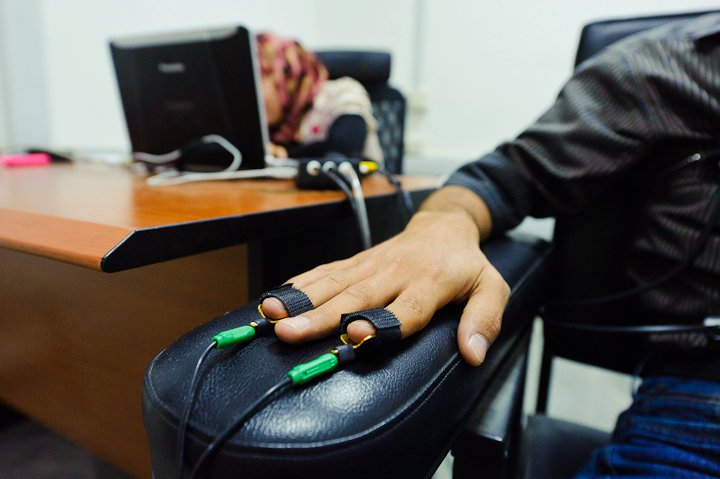Since ones started to deceive, the others started to develop methods for detecting deception and determining the truth. These methods in various aspects involve interviews and interrogations in attempt of making the deception visible and revealing the facts the deceiver cannot freely confess. In the 20th century, the discovery of lies acquired scientific dimensions regarding the development of methods that use physiological responses as indicators of deception. The most prominent of these is a polygraph, officially considered to be one of the greatest inventions of all times, the special machine included in the list of 325 greatest inventions of the Encyclopaedia Britannica Almanac in 2003.
Polygraph testing is widely used in the United States and some other countries (in particular, in Israel, Japan and Canada). Leonarde Keeler, a psychologist at Stanford University, is considered to be the father of «modern polygraph». Since his college years, he was fascinated by the machine of John Larson, namely by his so-called «cardiopneumophyogram» capable of detecting deception. Afterwards, L.Keeler worked on it to create a modern polygraph.
He became one of the best known polygraph experts to popularize the use of the device in criminal investigations. In 1939, Leonarde Keeler patented the machine these days considered to be the prototype of a modern polygraph, i.e., the Keeler’s polygraph. Just same year, Keeler Polygraph Model 6317 had been used to recruit soldiers, moreover, the CIA benefited from polygraph in detecting spies. In 1945, United States Intelligence service took advantage of polygraph to select personnel, thus forming and forging an administration in the occupation zone. However, this is not the case. Approximately three dozen SS and Gestapo officers were identified (roughly 40% of all tested).
One more American researcher, John E. Reid is one of the world’s most remarkable polygraphers and investigators, as well as the author of several world-renowned books on Polygraph issues. The fact is, in 1945 John E. Reid developed so-called Reid’s polygraph. Reid’s polygraph was the first instrument to use a motion sensor to detect the movement of an object at the study period. In 1947, John E. Reid achieved an outstanding breakthrough in polygraph techniques — the Reid’s control questions. He included an unexpected control question into the relevant / irrelevant technique. That is the major reason, nowadays John E. Reid is considered the «father control».
The success of the polygraph in and after World War II prompted the rise of the world’s first polygraph school, the Keeler Polygraph Institute in Chicago, in 1949, as well as the Central Intelligence Agency (CIA) Polygraph Department that same year. One of the distinguished alumni of the Keeler Polygraph Institute in Chicago was Norman Ansley, the author of plenty works, one of which was a book co-authored with Stanley Abrams ‘The polygraph profession’ (1980).
Years later, the US government decided to apply the polygraph to all CIA employees for, at least, once every five years. By the mid-1950s, polygraph had become an integral part of the CIA verification process. By 1952, the CIA polygraph program was operating worldwide. In 1954, the polygraph was officially used for general security audit in only three federal government agencies. All three were secret defense agencies: the Office of Operational Research (ORO), the CIA, and the National Security Agency (a printing unit founded in 1951). At ORO, all new staff members are tested and all operating personnel members are screened twice a year.
Cleve Backster has also contributed to the development of psychophysiological fraud detection. In 1960, the backster school of detection was established in New York; hence, among the graduates of the school there were polygraphers and intelligence officers such as Shirley H. Sturm and Robert W. Conners. Baxter’s concepts were widespread in the field of psychophysiological lie detection practice all around the world. Many of the graduates were the polygraph managers in their government offices and headmasters of printing schools.
In the late 1970s, a major breakthrough was the introduction of potential computer applications for polygraph diagram analysis. Since then, in the 1980s, Dr John C. Kircher and Dr David S. Ruskin had been conducting research at the University of Utah’s Psychological Laboratory on computerized polygraphs. The result of 1988 was the development of the «Computer Polygraphic System» (CAPS) by Dr. John S. Kircher and Dr. David S. Ruskin, which includes the first algorithm used to evaluate physiological data collected for diagnostic purposes.
In 1993, polygraph officially moves into the era of computers with the development of computer programming in the 1990s. Most modern polygraphs are controlled by computers. The development of sophisticated software enabled signals to be displayed on computer monitors, allowing researchers to more effectively detect violations. In the same years, Stanley Abrams sets the Western Oregon University’s School of Polygraph, the polygraphers from around the world attended, for instance, Wes Burns, Richard Smith, and Oleg Maltsev, back then the young post-Soviet scientist, who is an Academic today.
By the end of the 20th century, six dozen countries were already applying polygraphs. It is definitely worth saying, the 20th century was the brightest and most distinguished era, with both victories and achievements in the field of polygraph research and the ‘fierce’ active opposition to this method. The development of the applications was influenced by historical features, as well as the contacts and communications with forensics, courts, law enforcement and military services. Ideology and foreign policy dictated the rules resulting in the further popularization of the method.

